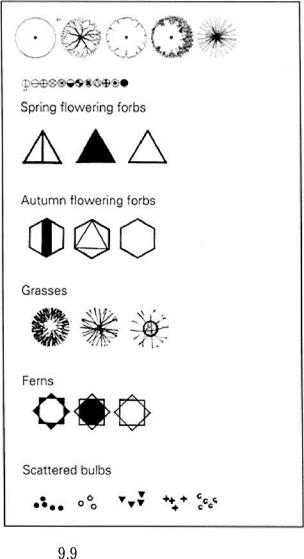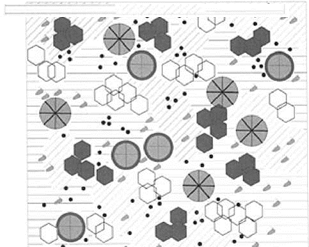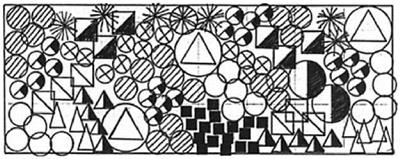The background to the Garden Habitat style of planting—or the ‘Hansen School’ of planting as it has come to be known after its greatest proponent, Professor Richard Hansen—is given in Chapters 2 and 3. In essence, this approach aims to mimic the spatial patterns of plants in the wild, using species and cultivars that are very well adapted to prevailing site conditions, and with a strong aesthetic element
 |
9.7
(a) A naturalistic planting plan showing the location of each individual plant
(b) Andropogon Associates Planting Plan—bog garden for Longwood Gardens. A naturalistic planting
plan with all the plants individually located
thrown in. There is much less emphasis on the block or the drift, and a far greater emphasis on the individual plant and its placing. Whilst each species may show a degree of clumping or aggregation, it is the interactions between these aggregates that gives rise to the naturalistic effect, and much of the visual beauty of these plantings.
The philosophical basis to Garden Habitat planting arises partly from ecological fitness to site principles, but also partly from spatial factors that describe the typical degree of association or aggregation of that species in the wild. As discussed in Chapter 4, five degrees of aggregation or Plant Sociability are recognised, ranging from isolated scattered individuals through to species that form dense monocultural stands. Most Garden Habitat plantings contain a mix of these different types to achieve complete vegetation cover. Moreover, there is a clear structural component to the plantings, with species classified according to their size, form and dominance in the planting.
A variety of graphical representations have been used to depict these naturalistic plantings. At the basic level, plans can simply label each individual plant (Figure 9.7a), but this becomes very difficult to follow when applied to plantings of any considerable size. A particular problem is that this type of planting relies on the repetition of species across the space. In Figure 9.7a it is very difficult to tell which species are repeating, and where. Implementing a plan such as this is very time-consuming and the laying out of plants has to be done bit by bit as one advances across the area. Of course, it is possible to give each plant a different colour or shading, but most technical planting plans have to be produced in black and white, and there are a limited number of patterns that can be used to identify each circle from the others.
A more sophisticated approach, and one that is much more common, is to give each plant its own symbol. For example, Figure 9.8 shows a similarsized area of planting to that depicted in Figure 9.7a,
|
|
9.8
A similar plan to 9.7, showing the location of each plant but, in this
instance, each species or cultivar has its own symbol
 |
Typical symbols for different plant types as used in the German ‘Garden Habitat’ approach to planting. These symbols help the
planner gain an impression of the flowering period of planting
|
|
9.10
Examples of graphic representation of groundcover species
but this time symbols are used instead of named circles. The structure of the planting is immediately more obvious and, importantly, it is relatively easy to see where each species is repeated. Standardised symbols can be applied to represent different plant types—the plan shown in Figure 9.8 uses these symbols. Figure 9.9 shows some of the common symbols used in planting plans in Germany.
Close examination of Figure 9.8 indicates that, although each individual plant is shown, much of the arrangement of the plants is into single species blocks or drifts. For some groupings, there is actually little need to show where each plant goes—it would be more efficient to indicate the boundaries of the group. This is particularly true of ground – cover plants where individuals merge to form a mass where no single plant is indistinguishable from any other. In such situations, it makes sense to show these plants as a mass rather than as individuals. These can still be illustrated symbolically by giving each group its own graphic, as indicated in Figure 9.10.
Figure 9.11 illustrates two plans where these techniques have been combined. A strong structural impression is given by these plans, with the arrangements of different types of perennials being clearly shown. Aggregated clump-forming species arise out of lower-growing and ground-covering masses, with larger, more solitary species scattered throughout. This structural or architectural approach represents the most straightforward way of composing such naturalistic planting plans and has achieved wide recognition through the Garden Habitat planting promoted by Hansen and Stahl (1993).
This approach is most commonly applied to perennials. The structure of the planting is determined by dominant perennials that are scattered rhythmically throughout and impose order on the planting. These ‘theme’ or emergent plants determine the character of the planting. Secondary plants fill-in spaces between the more dominant plants, according to their ‘sociability’ (see Chapter 4), whether they be
|
|
9.11
Some examples of combined symbol – based naturalistic planting plans

 |
dominant plants companion plants groundcover plants
scattered plants
9.12
The basic components of ‘Garden Habitat’ planting
aggregated ‘companion perennials’, ground-covering perennials or scattered perennials (Figure 9.12).






